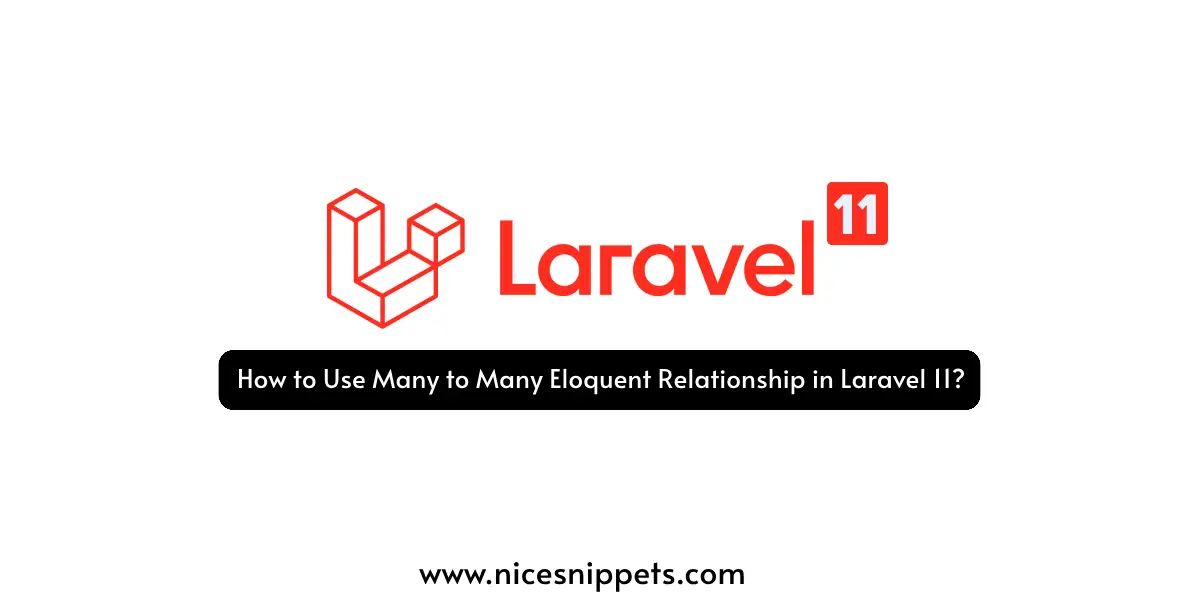12-Apr-2024
.
Admin

Hi, Dev
In this guide, I'll demonstrate how to implement a many-to-many relationship in a Laravel 11 application. We'll utilize the `belongsToMany()` Eloquent method to establish this relationship.
In Laravel, a many-to-many relationship between tables, such as "users" and "roles," signifies that each user can possess multiple roles, and each role can be associated with multiple users. The intermediary table, typically named "role_user," serves as a bridge to store these connections. This architecture enables flexible role assignments, facilitating diverse role combinations for users and shared roles across multiple users. Such flexibility streamlines the management of permissions and access levels within applications.
Many-to-many relationship will use "belongsToMany()" for relation.
Create Migrations:
Now we have to create migrations for the "users," "roles," and "role_user" tables. We will also add foreign keys to the "users" and "roles" tables. So let's create them as follows:
users table migration:
<?php
use Illuminate\Database\Migrations\Migration;
use Illuminate\Database\Schema\Blueprint;
use Illuminate\Support\Facades\Schema;
return new class extends Migration
{
/**
* Run the migrations.
*
* @return void
*/
public function up(): void
{
Schema::create('users', function (Blueprint $table) {
$table->id();
$table->string('name');
$table->string('email')->unique();
$table->timestamp('email_verified_at')->nullable();
$table->string('password');
$table->rememberToken();
$table->timestamps();
});
}
/**
* Reverse the migrations.
*
* @return void
*/
public function down(): void
{
Schema::dropIfExists('users');
}
};
roles table migration:
<?php
use Illuminate\Database\Migrations\Migration;
use Illuminate\Database\Schema\Blueprint;
use Illuminate\Support\Facades\Schema;
return new class extends Migration
{
/**
* Run the migrations.
*
* @return void
*/
public function up(): void
{
Schema::create('roles', function (Blueprint $table) {
$table->id();
$table->string('name');
$table->timestamps();
});
}
/**
* Reverse the migrations.
*
* @return void
*/
public function down(): void
{
Schema::dropIfExists('roles');
}
};
role_user table migration:
<?php
use Illuminate\Database\Migrations\Migration;
use Illuminate\Database\Schema\Blueprint;
use Illuminate\Support\Facades\Schema;
return new class extends Migration
{
/**
* Run the migrations.
*
* @return void
*/
public function up(): void
{
Schema::create('role_user', function (Blueprint $table) {
$table->foreignId('user_id')->constrained('users');
$table->foreignId('role_id')->constrained('roles');
});
}
/**
* Reverse the migrations.
*
* @return void
*/
public function down(): void
{
Schema::dropIfExists('role_user');
}
};
Create Models:
Here, we will create User, Role and UserRole table model. we will also use "belongsToMany()" for relationship of both model.
User Model:
<?php
namespace App\Models;
use Illuminate\Database\Eloquent\Factories\HasFactory;
use Illuminate\Foundation\Auth\User as Authenticatable;
use Illuminate\Notifications\Notifiable;
use Illuminate\Database\Eloquent\Relations\BelongsToMany;
class User extends Authenticatable
{
use HasFactory, Notifiable;
/**
* The attributes that are mass assignable.
*
* @var array
*/
protected $fillable = [
'name',
'email',
'password',
];
/**
* The attributes that should be hidden for serialization.
*
* @var array
*/
protected $hidden = [
'password',
'remember_token',
];
/**
* Get the attributes that should be cast.
*
* @return array
*/
protected function casts(): array
{
return [
'email_verified_at' => 'datetime',
'password' => 'hashed',
];
}
/**
* The roles that belong to the user.
*/
public function roles(): BelongsToMany
{
return $this->belongsToMany(Role::class, 'role_user');
}
}
Role Model:
<?php
namespace App\Models;
use Illuminate\Database\Eloquent\Factories\HasFactory;
use Illuminate\Database\Eloquent\Model;
use Illuminate\Database\Eloquent\Relations\BelongsToMany;
class Role extends Model
{
use HasFactory;
/**
* The users that belong to the role.
*/
public function users(): BelongsToMany
{
return $this->belongsToMany(User::class, 'role_user');
}
}
UserRole Model:
<?php
namespace App\Models;
use Illuminate\Database\Eloquent\Factories\HasFactory;
use Illuminate\Database\Eloquent\Model;
class UserRole extends Model
{
use HasFactory;
}
Retrieve Records:
$user = User::find(1);
dd($user->roles);
$role = Role::find(1);
dd($role->users);
Create Records:
$user = User::find(2);
$roleIds = [1, 2];
$user->roles()->attach($roleIds);
$user = User::find(3);
$roleIds = [1, 2];
$user->roles()->sync($roleIds);
$role = Role::find(1);
$userIds = [10, 11];
$role->users()->attach($userIds);
$role = Role::find(2);
$userIds = [10, 11];
$role->users()->sync($userIds);
I hope you understand of many to many relationship...
#Laravel 11